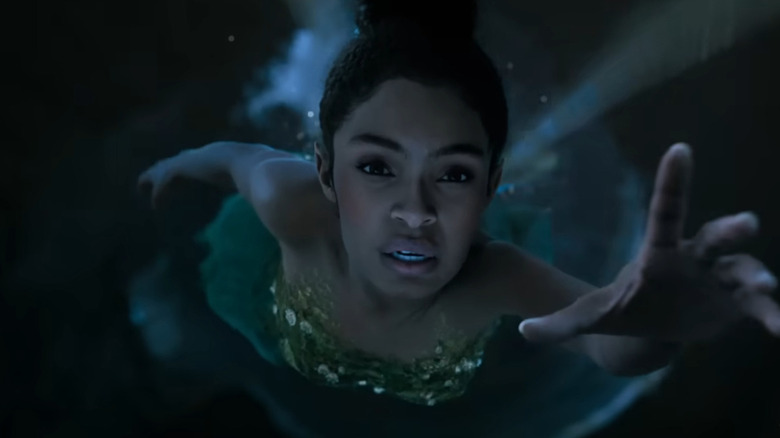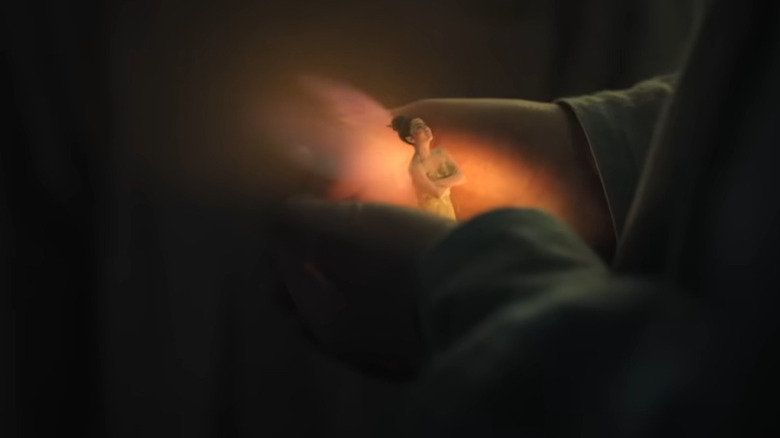Why Tinkerbell Doesn't Glow In The New Peter Pan & Wendy Movie
One can almost set their watch to film adaptations of J.M. Barrie's celebrated 1904 play "Peter and Wendy."
The story of the flying elf boy from Neverland and his friendship with a human girl from Earth was such a massive success and left such a strong cultural impact, that sequels and cross-media adaptations began cropping up only a few years after its debut. Barrie himself would turn the play into a novel in 1911, but that wasn't before he had already written two Peter Pan sequels in 1906 and 1908. The first filmed version of "Peter Pan" would be made by Herbert Brenon in 1924.
Perhaps the best-known adaptation, however, came to cinemas in 1953 when Walt Disney Studios released their animated version directed by Hamilton Luske, Clyde Geronimi, and Wilfred Jackson. The iconography from the Disney "Peter Pan" remains entrenched most firmly in the pop consciousness, and it continues to be one of the more heavily touted films in the Disney animated canon. To this day, the sparkling specter of the fairy Tinkerbell can be seen flying over the Disney castle in the studio's introductory logo.
Coming to Disney+ on April 28 will be David Lowery's "Peter Pan & Wendy," a live-action adaptation/pseudo-retread of the 1953 animated film. Alexander Molony will play Pan, Aver Anderson will play Wendy, and Jude Law will play the evil pirate Captain Hook.
Yara Shahidi ("Black-ish") will be playing Tinkerbell. Unlike most of the previous iterations, however, this Tinkerbell will not be a dancing light source of her own. This Tinkerbell will be as luminescent as you or I. In a recent interview with SFX, as reported on by CBR, Lowery declared that his fairy will be a character of flesh and blood; he was concerned, it seems, with the fineries of bioluminescence.
Think tink
There have been, of course, many, many film, book, and stage adaptations of "Peter Pan" since its inception, including a 1991 version made by Steven Spielberg, two adaptations in 2003 from P.J. Hogan and Daimon Dietz, a famed 2015 bomb from Joe Wright called "Pan," and Behn Zeitlin's "Wendy." As such, one might believe to know everything there is to know about Tinkerbell. A small Neverland fairy, Tinkerbell could shed a seemingly infinite supply of magical fairy dust from her wings. When a person is sprinkled with dust, their happy thoughts will allow them to fly. In some of the play's more famous musical adaptations (Leonard Bernstein made one in 1950, and Jerome Robbins made a more famous rendition in 1954), Tinkerbell was depicted by a small spotlight, giving the impression that Tinkerbell glowed from within her own body, sort of like a deep-water sea creature.
Perhaps wanting to avoid comparisons to anglerfish, Lowery made the aesthetic decision to keep Tinkerbell opaque for his new film. In live-action, he felt, a glowing fairy wouldn't possess the realistic tone he sought. He felt that audiences would become preoccupied with Tinkerbell's biological makeup. He said:
"We all imagine Tinkerbell glowing, but then you're like, 'Where's the light actually coming from? Do her wings light up?' That's the difference between animation and what looks right in live-action."
In the film's preview, one can see a glow coming from Tinkerbell's magical fairy dust, but none coming from the fairy herself. While Lowery is clearly not aiming for strict, earthy realism in his light fantasy film for children, he does understand the need to keep real gravity involved when shooting actual actors. While it stands counter to most of the known Tinkerbell depictions, Lowery's decision to make a non-glowing fairy makes creative sense.

